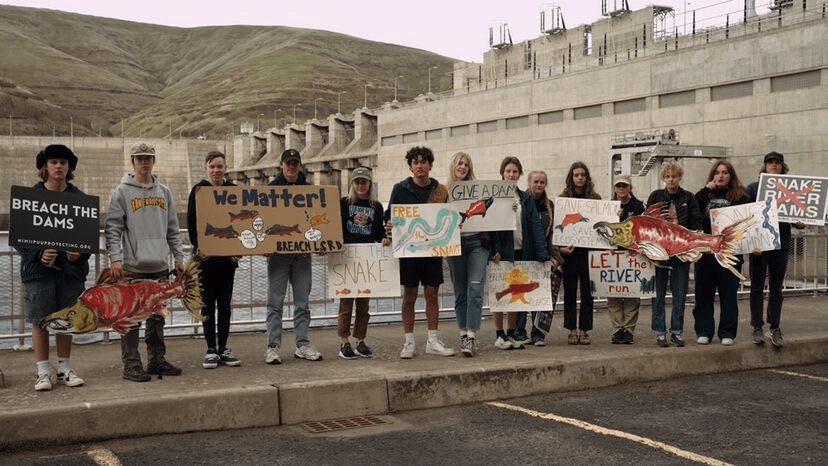forum
library
tutorial
contact

National Report Details Ways to Boost
Fish Recovery Efforts Along Columbia River
by Sydney Brown
The Daily News, October 10, 2022
|
the film forum library tutorial contact |

|
National Report Details Ways to Boost
by Sydney Brown
|
Columbia River salmon and steelhead populations remain "far below" historic levels.
On average, the yearly fish stock levels reach about 33% of its goal.
 Local leaders and researchers are finding new solutions to an old problem: helping endangered salmon and steelhead species across the Columbia River Basin.
Local leaders and researchers are finding new solutions to an old problem: helping endangered salmon and steelhead species across the Columbia River Basin.
Improving fish hatcheries, reintroducing young fish into dam-blocked areas and better water quality were listed as first-step solutions to fish recovery in the Columbia and Snake rivers, according to a report published last month from the National Oceanic and Atmospheric Association.
"This is a crucial time for the Columbia Basin's salmon and steelhead. They face increasing pressure from climate change and other longstanding stressors including water quality and fish blockages caused by dams," said Janet Coit, assistant administrator for NOAA Fisheries and acting assistant secretary of commerce for oceans and atmosphere at NOAA, in a news release. "The report identifies goals for the recovery of salmon and steelhead that will require a sustained commitment over many decades."
Columbia River salmon and steelhead populations remain "far below" historic levels, according to NOAA's report. On average, the yearly fish stock levels reach about 33% of its goal.
Some species are faring worse than others, according to the report. The Snake River coho and sockeye species would need an 80% generational growth rate to meet recovery goals; Upper Columbia steelhead would need about 70%.
Salmon recovery in Cowlitz County
Tribes and indigenous communities along the river basin have for centuries relied on the abundance of the cold-water fish, fish that find themselves in ever-warming rivers, NOAA said.
Recovery efforts have recently gotten financial help, with four Cowlitz County projects last month granted a total of $5.7 million in funding from the Washington State Salmon Recovery Funding Board.
The Lower Columbia Fish Enhancement Group has also focused efforts on education of local lakes and rivers, encouraging students to learn about how salmon contributes to a healthy ecosystem.
In September, the group got $5 million from the state salmon recovery board, the largest of Cowlitz County grants, to continue restoration projects on the South Fork of the Toutle River.
"Returning a river to more natural character and behavior that is hospitable for wild salmon is something that has been funded in the hopes that dwindling wild stock of salmon and steelhead would increase," said Brian Davern, board chair of the Lower Columbia Fish Enhancement Group.
In 2020, ecologists with the Cowlitz Indian Tribe led a watershed and habitat restoration project at Abernathy Creek, partnering with the Washington Department of Fish and Wildlife, the state Department of Ecology and the Lower Columbia Fish Recovery Board.
The dam question
The Pacific Northwest economy also leans on the commercial success of salmon.
The NOAA report comes as the discussion over whether to remove the four Lower Snake River dams sparked once again, gaining the attention of the White House.
Gov. Jay Inslee and U.S. Sen. Patty Murray, D-Wash, in June released a report that acknowledged the dams likely stood in the way of a sweeping fish recovery.
But getting rid of the dams remains a distant aspiration. In the same report, Inslee and Murray recognized the dams' important role in local economies, helping to support jobs and transport key products throughout the basin.
Several groups for these reasons have come out against breaching the dams, saying there are other solutions to the salmon problem like hydroelectricity or improving how the dams operate.
In the meantime, the 2022 NOAA report aimed to offer other ways local communities can support the endangered fish.
Greener solutions
The report lists the Upper Columbia and Snake River areas as the highest rebuilding priorities, based on the salmon and steelhead stocks. The Mid-Columbia region is also listed as a "high" priority.
In these regions, NOAA said increasing freshwater carrying capacity is "critical" to help juvenile fish, as it would help populations to rebound during good-weather years and offset effects of volatile ocean conditions.
Fish spawning and passage is also reliant on water quality, NOAA said. As temperatures warm the Columbia and Snake rivers and reduce river flows, places where adult salmon can lay eggs have dwindled.
NOAA's report suggests climate-focused changes, like using hydrology in the mainstem rivers and regularly taking on tributary habitat restoration projects.
Other solutions to increase water quality include irrigation system conversions, conservation and land-use modification centered around clean energy and sustainability, NOAA said. Helping to minimize predation could also allow more fish to return.
learn more on topics covered in the film
see the video
read the script
learn the songs
discussion forum
